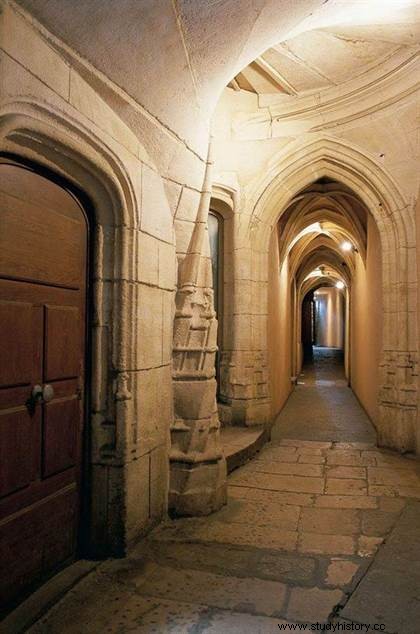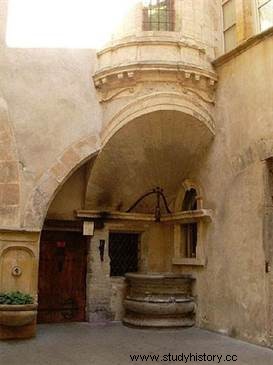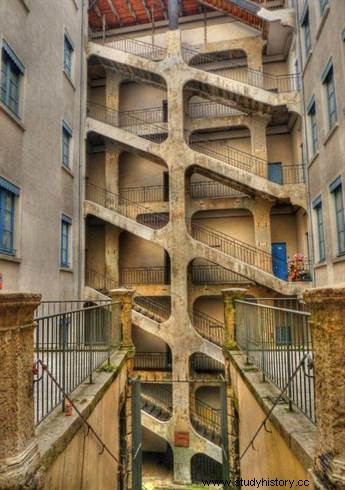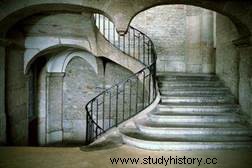 A sort of secret passages, the word "traboule is a typical word from Lyon. Amable Audin, historian and archaeologist breaks it down into “trans-ambulare” which literally means “to pass through”. Old Lyon, well restored, retains a special character with its traboules which form veritable labyrinths. The city has more than 400 traboules, including 200 in old Lyon. If by chance you pass by the city of gones, here are a few things to know about this subject.
A sort of secret passages, the word "traboule is a typical word from Lyon. Amable Audin, historian and archaeologist breaks it down into “trans-ambulare” which literally means “to pass through”. Old Lyon, well restored, retains a special character with its traboules which form veritable labyrinths. The city has more than 400 traboules, including 200 in old Lyon. If by chance you pass by the city of gones, here are a few things to know about this subject.
What is a traboule?
The traboule is a covered walkway reserved for pedestrians and which allows you to move from one street to another, passing under houses, through courtyards and stairs.
 The first traboules are believed to have been built in the 4th century. The inhabitants of Lugdunum, lacking water, settled on the banks of the Saône. The traboules were then used to quickly reach the river. In addition, the traboules were also used by the canuts, installed on the Croix-Rousse hill to quickly reach the fabric merchants installed at the bottom of the hill.
The first traboules are believed to have been built in the 4th century. The inhabitants of Lugdunum, lacking water, settled on the banks of the Saône. The traboules were then used to quickly reach the river. In addition, the traboules were also used by the canuts, installed on the Croix-Rousse hill to quickly reach the fabric merchants installed at the bottom of the hill.
Throughout history, these side roads have been the ideal tool to move around the city safe from the authorities, often unaware of their exact configuration . Until the invention of the digicode in 1970, they served as shelter and path for popular movements, for example during the Revolt of the Canuts or by the Resistance during the Second World War.
History of Traboules
The traboules represent one of the most original aspects of Lyon's architecture and identity. If we think that the first traboules made it possible to quickly reach the Saône, later, when drinking water wells were dug in the interior courtyards, access to the river became incidental. But, according to René Dejean, the common well, a privileged meeting place, “greatly contributed to giving their importance to the first traboules”. Later, the model of the Roman patio with its galleries and the well in the courtyard will often be copied during the many constructions of the Renaissance.
At Croix-Rousse, the traboules are the result of the construction of canut buildings. They made it possible to reach the Peninsula in a straight line. In 1862, the opening of the Ficelle, the first funicular in the world, made it possible to climb the slopes effortlessly, but the inhabitants came down again through the passages.
Certain traboules also played an essential role during the German occupation to shelter an underground Resistance. The resistants used this network of covered passages between the buildings allowing them to pass from one street to another where the Gestapo was sure to get lost. They also served as a parcel depot.
Where to see traboules in Lyon?
If we think that there are nearly 400 traboules in Lyon, a good number of them are today inaccessible to the public, because they are closed or even permanently condemned. Still, there are a few great ones that you can easily access.
 In old Lyon :
In old Lyon :
- 54 rue St Jean:long traboule comprising six small courtyards.
- 6 rue des Trois-Maries:entrance via an ocher facade, take two successive pink courtyards restored, Italian galleries and an exit via a heavily loaded door on a Renaissance style facade.
- 7 quai Romain-Rolland:in a 15th century building, go through two courtyards, one of which has a tower and an arched gallery, note the presence of an old well, exit is on the side of a 15th century façade with compartmentalized windows decorated with small worked columns.
- 3 place St Paul:this corner and rising traboule has at least seven steps, the entrance is modest , old and unrestored, the exit is vaulted, there is a staircase in the center of the traboule, the facade on the exit side dates from the 15th century with windows decorated with small columns.
At the Red Cross :
- 8, 11, 13 ascent of the Grande Cote:the whole dates from 1986 with a very beautiful view of Fourvière and the south of the city, go through two airy courtyards, four possible entrances and a side exit east.
- 30 bis rue Burdeau:traboule connected and parallel to the passage Thiaffait, a small opening leads to steep steps, beware of the low light and after three floors down you arrive in a paved courtyard with an old wall fountain, presence of three footbridges between the buildings.
- 9 place Colbert:small entrance to the alley, this is the most picturesque traboule and also the most visited in Lyon, it is also called "the court of the voracious" . The architecture is particular, in the first courtyard there is a large six-storey staircase, the exit is through a dark corridor overlooking another traboule.
On the Peninsula :
- 2 place Louis-Pradel:entrance through a large glass door in the alley. This courtyard is different from the others, because it is elevated with two stair rises. Alphonse Daudet lived in this house from 1849 to 1853.
- 2 rue des Forces:the facade does not correspond to the traboule, entrance by a double door and vaulted stairs giving access to the museum of the Bank and the printing house. The large courtyard followed by three long galleries along large green plants. Exit through a wrought iron gate.
- 26 quai St-Antoine:traboule-passage, one of the busiest in the city, includes a large gate on each side of the Lyon traffic jams.
- 9 rue Boissac:entrance with a vaulted ceiling and a courtyard with sculptures in the shape of cat's heads. Here is located the smallest bar restaurant in Lyon, the exit is through a high door whose facade is very kitsch (twelve balconies and sculptures in the shape of lion's heads) with an architecture where fifty-two large chimeras are represented supporting the roof.
Rue des Trois-passages:entrance via a paved alley going from rue de Fleurieu to reach the Cour des Trois-Passages. The large courtyard-garage surrounded by various buildings, the traboule leads to 8, rue de Fleurieu.
 If the traboule is a specificity of Lyon, just like Guignol and certain culinary specialties, Lyon has none not total monopoly. Indeed, some French cities also have them even if their name is not always the same. Thus, there are "traboules" in Saint-Etienne, "alleys" in Chambéry, "crossers" in Villefranche-sur-Saône and Marseille, "trages" or "traiges" in Besançon or incur "courses" in Nantes and Troyes. It should also be noted that some European cities such as Prague, London or Salzburg also have traboules.
If the traboule is a specificity of Lyon, just like Guignol and certain culinary specialties, Lyon has none not total monopoly. Indeed, some French cities also have them even if their name is not always the same. Thus, there are "traboules" in Saint-Etienne, "alleys" in Chambéry, "crossers" in Villefranche-sur-Saône and Marseille, "trages" or "traiges" in Besançon or incur "courses" in Nantes and Troyes. It should also be noted that some European cities such as Prague, London or Salzburg also have traboules.
To go further...
- René Dejean, Traboules de Lyon, the secret history of a city, ed. des Traboules, 2003
- Guide to Lyon and its traboules, by Corinne Poirieux. ELAH, 2009.
